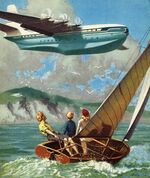Development of aircraft in Burgundie
| This article is a stub. You can help IxWiki by expanding it. |
For much of its early aviation history, 1850s-1940s, Burgundie was a leader in airship design and production. During the latter half of the Second Great War with the boom of airplane technology Burgundie fell behind. It’s attempts at early airplane and jet design were rudimentary and most often outsourced to more experienced nations. During Operation Kipling Burgundie saw a locally important development of a military jet aircraft industry. Following the Quds War, Burgundie has continued to focus on building aircraft for its own domestic market but has increasingly involve its Levantine Union Defense Council allies in the R&D to ensure it is meeting modern standards.
Early balloons
Therisse-Balthazar Phancis de Marin is credited with designing the first successful Burgoignesc aerostat, The duckling, in 1811.
During the mid and late 19th century there was a boom of airship development. The cigar-shaped envelope became fairly standardized across the designs by the 1870s with most of the innovation occurring around propulsion and steering. With the launch of The Burgundie (BG: La Burgondia) in 1886 by the Army of Burgundie, the Army not the royal court became the primary driver behind aerostat development, under the Airship Brigade. It was under their command that the various aerostat designs were given secondary importance and the dirigible became the primary airship in Burgundie.
Dirigibles
Despite the success of The Burgundie the Carbonneau Rigid Airboat Company won a massive contract to provide the Army Airship Brigade with 40 Corsair class dirigibles in 1899. This is the first class of military airships in Burgundie and were attached to artillery batteries and various elements of the signal corps during the War of the Faskano Straight.
Burgundian Imperial Airship Scheme
In 1918, Following the fiasco of the War of Faskano Strait, Emperor August I concocted a scheme to connect the various cities of the Holy Levantine Empire to her countries colonies and to the world.
Emirati War
Main article: Emirati War

Between Burgundie, the United Pukhgundian Emirates, the Trucial States, and the Emirate of Kagazi. 1871-1897. 1880s Observation balloons, the first recorded use of a lighter than air vehicle to drop a device for a military purpose. Dropped a fused grenade.
First Great War
Main article: First Great War Blimps and shit
Interwar Developments
The Interwar Period, (Burg: le Intermezzo Splendide), spanning 1902-1934.
Flying boats, creation of the Royal Air Service of Burgundie, lots of experimentation, lots of glass for observation, mostly wood and fabric until the early 30s then a rapid jump to steel and aircraft aluminum.
Largebody fixed wing airframes


(bombers, cargo, and transports)
Smallbody fixed wing airframes
Helicopters
Gyroscopes
Aerostats
Second Great War
Main article: Second Great War
- Abrams P-1 Explorer in areas where Burg had air superiority in 1937-1942, mostly Audonia and Alshar and Sudmoll
- Amiot 143 and other gondola bombers, the Derians didn't have a massive air capability yet so this would have been typical as the unprotected undercarrage wouldn't have been as much of a risk as you think it would.
- SNCASE SE.100 this was the main land based intercepter/attack aircraft of the Army Airforce from 1937-1945
- SNCASE SE-400 coastal patrol floatplane
- Bréguet 790 Nautilus coastal patrol flying-boat
Jet age


While many of its contemporaries in the Great War focused on building massive numbers of bomber aircraft, Burgundie had focused on building transports to maneuver its soldiers and equipment all across its vast Burgoignesc Thalattocracy. These airframes were much easier to convert into commercial airliners and in the 1960s and 1970s Burgundie held the majority of airframe provider contracts. As Operation Kipling dragged the aircraft industry back into wartime production, they lost their edge and numerous states developed organic commercial aircraft capabilities to supplant the dearth of Burgundian aircraft.
Counter-insurgency aircraft
As Operation Kipling devolved into a massive endless asymmetric war of attrition and the Burgoigniacs achieved air superiority over vast swathes of Alshar it became clear that there was no need for massive numbers of expensive mid-generation jet aircraft. As a cost-saving development in the late 1960s and early 1970s the Royal Air Service of Burgundie reactivated some of their propeller aircraft from the Great War. These aircraft served well and a separate line of manufacturing was retooled to create modern light attack aircraft. Given Burgundie's consistent involvement in asymmetric counterinsurgency warfare (e.g. Quds War, Second Bulkhan War, etc.) the manufacture of propeller-driven light attack aircraft has taken a prominent role in Army aviation. The Revenue Guard partnered with the Army of Burgundie as this type of airframe fits their role perfectly. Demilitarized formats are common in the Civil Air Patrol Branch of the Emergency Military Unit.
- North American Rockwell OV-10 Bronco 1969-1995
- Cavalier Turbo Mustang III 1969-1974
- Fairchild AU-23 Peacemaker 1971-1983
- FMA IA 58 Pucará 1974-1998
- Britten-Norman Defender 1976-1999* Defender 4000 1996-present
- Embraer EMB 314 Super Tucano 2005-present
Unmanned Aircraft Systems
Something, something aerial target drones in the 1910s. Aireal torpedoes in the 1920s. Recon in the 1970s. Missile system decoy in the 1980s and 1990s. "maturing and miniaturization of applicable technologies in the 1980s and 1990s, interest in UAVs grew". Attack and recon in the 21st century. Hewitt-Sperry Automatic Airplane 1919-1932
- Kettering Bug 1919-1925
- Ryan AQM-91 Firefly 1971-1976
- Dassault nEUROn 2017-present
- Singular SA03 2018-present